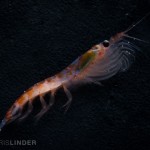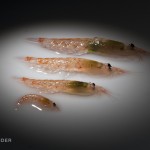“Synergistic effects of elevated carbon dioxide (CO2) and temperature on the metabolism, growth, and reproduction of Antarctic krill (Euphausia superba)”
There are predictions that by the end of this century the Southern Ocean will be the first region to be affected by seawater chemistry changes associated with enhanced (increased levels of) CO2. Increased levels of CO2 in the atmosphere is resulting in ocean acidification (increases in the acidity of the ocean water). Elevated CO2 can impact marine organisms by disturbing their internal acid-base (metabolic) equilibrium. The inability to compensate or the increased energetic costs of organisms to compensate for increased levels of CO2 may cause long-term shifts in respiration and metabolic equilibria. This could eventually hamper the growth and reproduction of the organisms, and therefore effect the larger population. At the same time that ocean acidification is impacting organisms, rapid warming in the Western Antarctic Peninsula (WAP) region is occurring and is associated with an overall decline in primary, secondary, and higher trophic levels, including Antarctic krill (Euphausia superba).
Ocean acidification and warming may act synergistically (together) to impair animal performance by simultaneously increasing metabolic needs and reducing oxygen transport, which may eventually negatively impact a krill population that has already declined two-fold since the mid-1970s. However, no studies have measured krill acid-base regulation, metabolism, growth, or reproduction in the context of ocean acidification or combined “greenhouse” conditions of increased CO2 and temperature. Therefore, during two consecutive field seasons at Palmer Station, we will conduct prolonged exposure experiments to determine the responses of E. superba to elevated CO2 and temperature, determine potential costs of increased energetic demand and potential acclimation of krill to high CO2, pinpoint the underlying physiological mechanisms of CO2 and temperature induced responses, and understand the associated feedbacks on the ecosystem and biogeochemical cycles.
Specifically the scientists will:
 Experiment 1: Examine the independent and synergistic (combined) effects of CO2 and temperature on acid-base regulation and metabolic physiology of adult Euphausia superba. We will conduct both short (48 hours) and prolonged (21 days) exposure experiments at ambient (current or normal) CO2 and temperature levels and those predicted by year 2100 (750 ppm CO2; +2°C more than today’s temperature). Specifically, we will monitor over time krill internal acid-base regulation (blood pH, hemocyanin/O2 equilibration), oxygen binding ability, oxygen consumption (respiration), and rates of feeding and nutrient excretion. Conducting short and prolonged incubations will provide insight into the tolerance and potential acclimation of Antarctic krill to impending ocean conditions.
Experiment 1: Examine the independent and synergistic (combined) effects of CO2 and temperature on acid-base regulation and metabolic physiology of adult Euphausia superba. We will conduct both short (48 hours) and prolonged (21 days) exposure experiments at ambient (current or normal) CO2 and temperature levels and those predicted by year 2100 (750 ppm CO2; +2°C more than today’s temperature). Specifically, we will monitor over time krill internal acid-base regulation (blood pH, hemocyanin/O2 equilibration), oxygen binding ability, oxygen consumption (respiration), and rates of feeding and nutrient excretion. Conducting short and prolonged incubations will provide insight into the tolerance and potential acclimation of Antarctic krill to impending ocean conditions.
Experiment 1 Hypotheses:
- A) Krill metabolism is compensated completely in response to elevated CO2. or B) Krill do not compensate completely, leading to metabolic suppression.
- Krill may initially respond as described in Hypothesis 1a, but under chronic exposure to elevated CO2 and temperature, the response may shift to that described in Hypothesis 1b.
- The extra costs of compensation (e.g. higher demands for internal acid-base regulation) are necessary to protect oxygen transport due to pH sensitivity of hemocyanin/oxygen binding.
Experiment 1 Set-up:
Control & Treatments:
- Today’s CO2 and temperature conditions (Control)
- High CO2 and today’s temperature conditions (CO2 treatment)
- High CO2 and high temperature conditions (Year 2100/”greenhouse” treatment)
Replicates: There will be 25 replicates of each control/treatment.
Measurements: We will measure the feeding rates, excretion amounts, oxygen consumption, and internal pH and acid-base regulation of the adult krill.

Experiment 2: Determine potential changes in growth and reproduction of Euphausia superba due to increased temperature and the increased energetic cost of acid-base regulation to compensate for increased CO2. In prolonged exposure experiments (30 days) under varying levels of CO2 and temperature, we will 1) monitor growth rates in juvenile krill, 2) determine spawning frequency and fecundity in adult gravid female krill, and 3) measure internal acid-base regulation parameters and oxygen binding ability in both adult female and juvenile krill. Looking at multiple krill life stages will help to identify critical life cycle phases that may be more vulnerable to climate change and will help to predict the fate of Antarctic krill populations in a rapidly changing climate.
Experiment 2 Hypotheses:
- Under conditions of high CO2 in perturbation experiments, growth rates of juvenile krill and spawning frequency and fecundity of adult gravid female krill will be reduced compared to krill in ambient CO2 and temperature treatments.
- These reductions in krill growth and reproduction under elevated CO2 are caused by higher demands for internal acid-base regulation or a metabolic suppression.
Experiment 2 Set-up:
Control & Treatments:
- Today’s CO2 and temperature conditions (Control)
- High CO2 and today’s temperature conditions (CO2 treatment)
- High CO2 and high temperature conditions (Year 2100/”greenhouse” treatment)
Replicates: There will be 25 replicates of each control/treatment.
Measurements: We will measure internal acid-base regulation, juvenile growth rates, and spawning frequency/fecundity in pregnant females.
Interested in reading the full Project Description of “Synergistic effects of elevated carbon dioxide (CO2) and temperature on the metabolism, growth, and reproduction of Antarctic krill (Euphausia superba)”? Project Description
